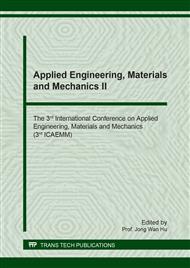[1]
B. King et al, Vacuum filtration based formation of liquid crystal films of semiconducting carbon nanotubes and high performance transistor devices. Nanotech. 25 (2014) 175201.
DOI: 10.1088/0957-4484/25/17/175201
Google Scholar
[2]
Y. Hosoi et al, Infrared spectroscopy of pentacene thin film on SiO2 surface, Appl. Surf. Sci. 244 (2005) 607-610.
DOI: 10.1016/j.apsusc.2004.10.131
Google Scholar
[3]
R. P. Ortiz et al, High-k Organic, Inorganic and Hybrid Dielectrics for Low-Voltage Organic Field-Effect Transistors, Chem. Rev. 110 (2010) 205-239.
DOI: 10.1021/cr9001275
Google Scholar
[4]
J. Wang et al, Nonlinear optical properties of carbon nanotubes hybrids in polymer dispersions, Mater. Chem. Phys. 133 (2012) 992-997.
Google Scholar
[5]
J. Wang et al, Carbon nanotubes and nanotube composites for nonlinear optical devices, J. Mater. Chem. 19 (2009) 7425-7443.
Google Scholar
[6]
J. Wang et al, Linear and nonlinear spectroscopic studies of phthalocyanine-carbon nanotube blends, Chem. Phys. Lett. 465 (2008) 265-271.
DOI: 10.1016/j.cplett.2008.09.073
Google Scholar
[7]
R. Basu, Effect of carbon nanotubes on the field-induced nematic switching, Appl. Phys. Let. 103 (2013), 241906.
DOI: 10.1063/1.4846676
Google Scholar
[8]
A. García-García et al, Electrical response of liquid crystal cells doped with multi-walled carbon nanotubes, Beilstein J. Nanotechnol. 6 (2015) 396–403.
DOI: 10.3762/bjnano.6.39
Google Scholar
[9]
J. Wang et al, The importance of solvent properties for optical limiting of carbon nanotube dispersions, Opt. Comm. 283 (2010) 464-468.
DOI: 10.1016/j.optcom.2009.10.020
Google Scholar
[10]
Y. Almadori et al, Chromophore ordering by confinement into carbon nanotubes, J. Phys. Chem. C. 118 (2014) 19462.
Google Scholar
[11]
K. Shirasu et al, Potential use of CNTs for production of zero thermal expansion coefficient composite materials: An experimental evaluation of axial thermal expansion coefficient of CNTs using a combination of thermal expansion and uniaxial tensile tests. Composites: Part A 95 (2017).
DOI: 10.1016/j.compositesa.2016.12.027
Google Scholar
[12]
X. Ai et al, Phase modification of copper phthalocyanine semiconductor by converting powder to thin film. App. Surf. Sci. 428 (2018) 788-792.
DOI: 10.1016/j.apsusc.2017.09.146
Google Scholar
[13]
M. Syzbowicz et al, The molecular structure ordering and orientation of the metallophthalocyanine CoPc, ZnPc, CuPc and MgPc thin layers deposited on silicon substrate, as studied by micro-Raman spectroscopy, J. Mater. Sci 46 (2011) 6589-6595.
DOI: 10.1007/s10853-011-5607-4
Google Scholar
[14]
X. Wang et al, Studies on structure and raman spectroscopy of Ni-doped copper pthalocyanine thin films. App. Surf. Sci. 297 (2014) 188-194.
Google Scholar


